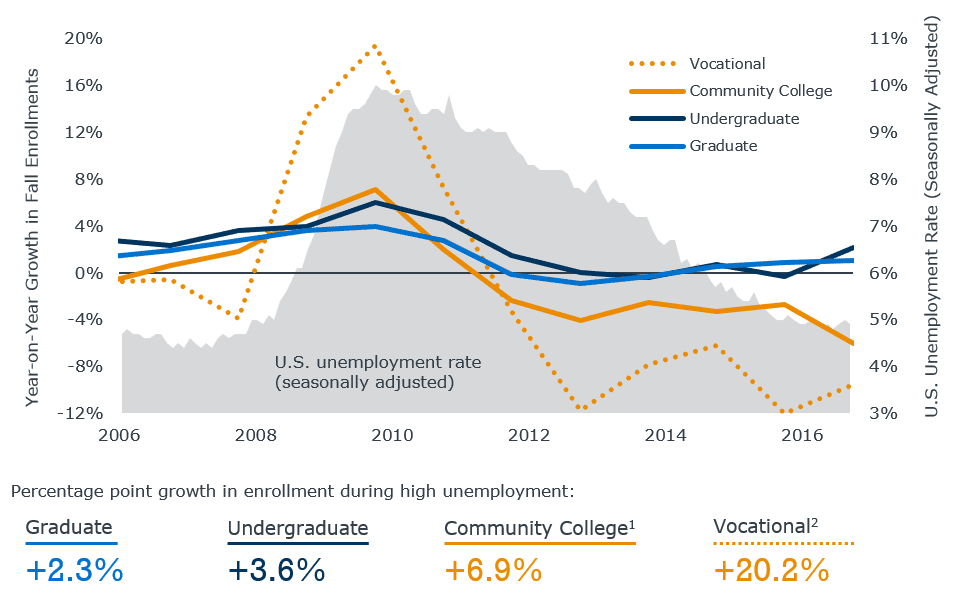Which institutions benefit most from countercyclical enrollment growth?
If trends from the last recession hold, most four year undergraduate and graduate programs won’t get a boost.
Facing an economic downturn and fierce competition for undergraduate enrollments, colleges and universities are looking for a silver lining: countercyclical enrollments. This tendency for enrollments to increase as the economy declines is well documented. But leadership at four-year institutions shouldn’t get their hopes up. Not every institution benefits equally from these additional students. The Great Recession had a far smaller impact on baccalaureate and graduate enrollments than it did on community colleges and vocational programs.
What happened during the Great Recession of ‘08?
The Great Recession did not reduce the number of students willing to invest in a college education, despite reducing average household incomes by more than 8%. In fact, the opposite happened. As unemployment peaked in 2009, overall enrollments in higher education grew at their fastest rate in over thirty years.
However, these students weren’t looking for an advanced degree to upskill or “re-skill” for high-pay career fields. Many were instead choosing to go to college for vocational training, or to finally complete a degree they’d started years ago.

1 Includes all public 2-year institutions.
2 Includes all less-than-2-year institutions and all private nonprofit and for-profit 2-year institutions.
Source: IPEDS fall enrollment data 2005-2018; Bureau of Labor Statistics unemployment data; EAB interviews and analysis.
Countercyclical enrollment primarily a sub-baccalaureate trend, with most growth in vocational programs
The vast majority of countercyclical students turned to 2-year institutions during the 2008 recession. Drawn by cheaper, convenient, and career-focused programs, about 70% of countercyclical students enrolled in community colleges and vocational institutions. Of these, many went to vocational institutions. As unemployment rose from late 2008 through 2010, enrollment growth at these institutions spiked by more than 20 percentage points.
Many unemployed workers saw a clear path back into the workforce in the short-format career-oriented programs offered at these institutions. The most popular included medical assistant training, cosmetology, massage therapy, commercial driver’s license (CDL) training, and training for automotive mechanics.
Unfortunately for vocational institutions and community colleges, enrollments went back down during the recovery after the Great Recession. As the economy improved, student counts declined by 2-6% each year for community colleges, and by as much as 12% a year for vocational institutions.
There’s also reason for community colleges to be cautious this time around. With FAFSA filings down and no prospect of a Pell grant expansion similar to the last recession, enrollments may not grow at nearly the same rate.
See ways schools can help unemployed workers
Almost all countercyclical growth at 4-year institutions came from nontraditional students
The countercyclical growth at four-year institutions came not from more high school graduates choosing to go to college, but from older students, many of whom were completing a degree after stopping out of college. From 2007 to 2011, the number of students 25 and older increased by more than 7% each year on average, far exceeding normal growth rates. By contrast, growth in traditional students barely changed. Most of this growth likely took place in degree completion programs, as more unemployed workers returned to college to finish a bachelor’s degree.

Graduate programs benefited the least from countercyclical enrollments during the Great Recession
Many leaders at 4-year institutions hope to launch or grow professional graduate programs, to recoup losses and develop a highly skilled workforce for their regional economies. This strategy seems like a good bet—it makes sense that there would be student demand for programs that develop in-demand skills to secure high-paying careers in a competitive market. During the last recession, graduate enrollments did increase, but not by much. What’s more, for-profit institutions accounted for much of this increase, growing enrollments by 22% in 2008 alone. However, more than 90% of graduate students attend public and private non-profit institutions and enrollments at these institutions increased only slightly.
One reason for this much-slower growth was that graduate programs weren’t even an option for most countercyclical students. Most unemployed workers during the Great Recession didn’t have the bachelor’s degrees they would need to attend graduate school. In 2010, only 20% of the unemployed held a bachelor’s degree, compared with 65% who had at least a high school diploma, but no bachelor’s degree.
There’s still reason for some optimism: 2020’s more educated workforce could boost graduate programs
This time, it’s possible that more students will enroll in graduate education in the coming recession. The U.S. workforce is more educated today compared with ten years ago. In 2020, 44% of workers held a bachelor’s degree or higher, compared with just 34% in 2010. As a result, unemployed workers are also more educated. In May 2020, 28% of unemployed workers held at least a bachelor’s degree, equaling an additional 1.5 million potential students for graduate programs.
-
44%
of workers hold a bachelor’s degree or higher in May 2020, compared with just 34% in 2010
The spread of online graduate programs allows public, and private non-profit institutions to better serve countercyclical students today compared with a decade ago. Online graduate programs, once synonymous with for-profit institutions, allow unemployed workers to study at home rather than relocate. Today, convenient and accessible online graduate programs are common at public and private, non-profit institutions.
Why 2020 is not a rerun of the Great Recession
While historical trends suggest that enrollments could increase this fall, university leaders should be cautious about expecting 2008 trends to repeat themselves.
- An online-only fall semester could dissuade traditional students: Seeking an in-person college experience, some traditional-age students might wait until it’s completely safe to take classes in-person, offsetting any potential gains from unemployed workers.
- Anticipating a quick recovery, workers may hold out on reskilling plans: If unemployed workers expect a rapid recovery and a quick return to work once COVID-19 outbreaks are controlled, they will have fewer incentives to invest in their education.
- No repeat of 2008’s financial aid expansion: With FAFSA completion rates down and an increase in Pell Grant awards unlikely, financial constraints could limit countercyclical enrollment growth.
- Alternative providers could put a dent in the enrollment bump: Today’s unemployed workers have more options for gaining new skills, especially in computer science and technical fields. Coding bootcamps, certifications from big tech companies, and “infotainment” subscriptions from companies like Duolingo and MasterClass could compete with post-baccalaureate certificates.

More Blogs

Demographics shape the enrollment landscape, but strategy determines success

What changed in the graduate lead gen landscape in 2025
